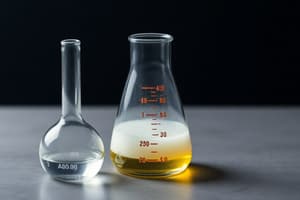Podcast
Questions and Answers
Why are common names generally unsuitable for scientists when identifying new species?
Why are common names generally unsuitable for scientists when identifying new species?
- They can be ambiguous and vary by region or language. (correct)
- They accurately reflect the evolutionary relationships between organisms.
- They are universally standardized and recognized across languages.
- They are more precise and descriptive than scientific names.
What is the correct format for writing a species name under binomial nomenclature?
What is the correct format for writing a species name under binomial nomenclature?
- Genus species (species capitalized and italicized)
- Genus species (Genus capitalized and italicized) (correct)
- Genus species (both italicized)
- Genus species (Genus capitalized and underlined)
Which two taxonomic ranks are the broadest (highest) within the Linnaean system of classification?
Which two taxonomic ranks are the broadest (highest) within the Linnaean system of classification?
- Kingdom and Domain (correct)
- Class and Order
- Phylum and Species
- Family and Genus
Traditional classification systems considered which two primary characteristics when categorizing organisms?
Traditional classification systems considered which two primary characteristics when categorizing organisms?
Before the three-domain system was established, all life was classified into which two kingdoms?
Before the three-domain system was established, all life was classified into which two kingdoms?
In the past, organisms from the kingdoms Eubacteria and Archaebacteria were grouped together in a single kingdom. What was this kingdom called?
In the past, organisms from the kingdoms Eubacteria and Archaebacteria were grouped together in a single kingdom. What was this kingdom called?
Which characteristic primarily distinguishes organisms in the domains Bacteria and Archaea?
Which characteristic primarily distinguishes organisms in the domains Bacteria and Archaea?
How does the concept of 'common ancestry' relate to the construction of cladograms?
How does the concept of 'common ancestry' relate to the construction of cladograms?
Which of the following is the most accurate definition of a 'derived character' in cladistics?
Which of the following is the most accurate definition of a 'derived character' in cladistics?
How does genetic analysis contribute to modern taxonomic classification?
How does genetic analysis contribute to modern taxonomic classification?
Flashcards
Binomial Nomenclature
Binomial Nomenclature
A naming system where each species is assigned a two-part scientific name.
Genus
Genus
The first part of a scientific name, indicating the genus to which the species belongs.
Species
Species
A group of living organisms consisting of similar individuals capable of exchanging genes or interbreeding.
Mammalia
Mammalia
Signup and view all the flashcards
Derived Character
Derived Character
Signup and view all the flashcards
Cladograms
Cladograms
Signup and view all the flashcards
Common Ancestry
Common Ancestry
Signup and view all the flashcards
Kingdom of Eukaryotes
Kingdom of Eukaryotes
Signup and view all the flashcards
Kingdom of Fungi
Kingdom of Fungi
Signup and view all the flashcards
Study Notes
Reaction Rate
- Reaction rate refers to the change in concentration of reactants or products per unit time.
Rate Law
- The rate law describes the relationship between the rate of a reaction and reactant concentrations.
- For the reaction $aA + bB \rightarrow cC + dD$, the rate law is $rate = k[A]^m[B]^n$.
- $k$ stands for the rate constant.
- [A] and [B] represent reactant concentrations.
- $m$ and $n$ are the reaction orders with respect to A and B.
Reaction Order
- Reaction order is the sum of the exponents in the rate law (e.g., $m + n$).
- Zero order: $rate = k$ (rate is independent of reactant concentration).
- First order: $rate = k[A]$ (rate is directly proportional to [A]).
- Second order: $rate = k[A]^2$ or $rate = k[A][B]$.
Factors Affecting Reaction Rate
- Temperature and Catalysts are significant factors
Temperature and Arrhenius Equation
- Arrhenius Equation: $k = Ae^{-E_a/RT}$.
- $k$ is the rate constant.
- $A$ pre-exponential factor.
- $E_a$ is the activation energy.
- $R$ is the gas constant ($8.314 J/(mol \cdot K)$).
- $T$ is the temperature in Kelvin.
Catalysts
- Catalysts lower the activation energy ($E_a$), increasing the reaction rate.
Reaction Mechanisms
- Reaction mechanisms involve elementary steps and typically have a rate-determining step
Elementary Steps
- Elementary steps are single steps in a reaction mechanism.
Rate-Determining Step
- The rate-determining step is the slowest step, dictating the overall reaction rate.
Equilibrium
- Equilibrium involves an Equilibrium Constant and is altered by Condition changes
Equilibrium Constant ($K_c$)
- For $aA + bB \rightleftharpoons cC + dD$, the equilibrium constant ($K_c$) is: $K_c = \frac{{[C]^c[D]^d}}{{[A]^a[B]^b}}$.
Le Chatelier's Principle
- Le Chatelier's Principle: A system at equilibrium shifts to relieve stress from changes.
Changes in Condition
- Concentration: Adding reactants shifts equilibrium to products, and vice versa.
- Pressure: Increasing pressure shifts equilibrium to the side with fewer gas moles, and conversely.
- Temperature: Increasing temperature favors endothermic reactions.
Acid-Base Chemistry
- Arrhenius Acids produce $H^+$ ions in water.
- Arrhenius Bases produce $OH^-$ ions in water.
- Bronsted-Lowry Acids donate protons ($H^+$).
- Bronsted-Lowry Bases accept protons ($H^+$).
- Lewis Acids accept electron pairs.
- Lewis Bases donate electron pairs.
pH Scale
- $pH = -log[H^+]$
- $pOH = -log[OH^-]$
- $pH + pOH = 14$ at $25^\circ C$
Acid-Base Strength
- Strong Acids completely dissociate in water (e.g., $HCl, H_2SO_4$).
- Strong Bases completely dissociate in water (e.g., $NaOH, KOH$).
- Weak Acids/Bases partially dissociate in water.
Acid Dissociation Constant ($K_a$)
- For weak acid $HA$: $HA \rightleftharpoons H^+ + A^-$
- $K_a = \frac{{[H^+][A^-]}}{{[HA]}}$
- $pK_a = -log(K_a)$
Base Dissociation Constant ($K_b$)
- For weak base $B$: $B + H_2O \rightleftharpoons BH^+ + OH^-$
- $K_b = \frac{{[BH^+][OH^-]}}{{[B]}}$
- $pK_b = -log(K_b)$
Relationship between $K_a$ and $K_b$
- For a conjugate acid-base pair: $K_a \cdot K_b = K_w$
- $K_w$ is the ion product of water ($1.0 \times 10^{-14}$ at $25^\circ C$)
Buffers
- Buffers resist pH changes upon addition of small amounts of acids or bases.
Henderson-Hasselbalch Equation
- For acidic buffer:$pH = pK_a + log \frac{{[A^-]}}{{[HA]}}$
- For basic buffer:$pOH = pK_b + log \frac{{[BH^+]}}{{[B]}}$
Titration
- Titration is the process of determining the concentration of a solution by reacting it with a solution of known concentration.
Equivalence Point
- The equivalence point is where acid and base have completely reacted during titration.
Endpoint
- The endpoint is where the indicator changes color during titration.
Indicators
- Indicators change color based on solution pH.
Amino Acids and Proteins
- Amino acids are the building blocks of proteins
- Proteins are important to body functions.
General Formula
- General formula: $NH_2-CHR-COOH$.
- "R" group differentiates amino acids.
Classes of Amino Acids
- Several classes are defined R groups
Nonpolar, Aliphatic R Groups
- Hydrophobic
- Include: Glycine, Alanine, Proline, Valine, Leucine, Isoleucine, Methionine.
Aromatic R Groups
- Relatively nonpolar
- Include: Phenylalanine, Tyrosine, Tryptophan.
Polar, Uncharged R Groups
- Hydrophilic
- Include: Serine, Threonine, Cysteine, Asparagine, Glutamine.
Positively Charged R Groups
- Hydrophilic
- Include: Lysine, Arginine, Histidine.
Negatively Charged R Groups
- Hydrophilic
- Include: Aspartate, Glutamate.
Titration of Amino Acids
- Amino are weak acids with at least two dissociable protons, $H^+$
- Titration with a base ($NaOH$) reveals two deprotonation stages.
Peptide Bond Formation
- Amino acids link via peptide bonds to form peptides/proteins.
- Peptide bond: amide bond between the $\alpha$-carboxyl of one amino acid and the $\alpha$-amino of another.
- Peptide bond formation releases water.
Protein Structure
- There are 4 levels to the protein hierarchy
Primary Structure
- Primary structure: linear amino acid sequence.
- Determined by amino acid sequence.
- Determines higher-level structures.
Secondary Structure
- Secondary structure: local spatial arrangement of polypeptide backbone.
- Common types: $\alpha$-helix and $\beta$-sheet.
Tertiary Structure
- Tertiary structure: overall 3D arrangement of all atoms in the protein.
- Stabilized by hydrophobic interactions, hydrogen bonds, disulfide bonds, and ionic interactions.
Quaternary Structure
- Quaternary structure: arrangement of multiple polypeptide chains in multi-subunit proteins.
- Not all proteins have this structure
- Subunits held together by interactions stabilizing tertiary structure.
Protein Folding
- The process by which a protein acquires its native three-dimensional structure is termed protein folding
- Driven by the hydrophobic effect.
- Assisted by chaperone proteins, which prevent misfolding and aggregation.
Protein Misfolding and Disease
- Misfolding leads to diseases like Alzheimer's, Parkinson's, and Huntington's.
- Misfolded proteins aggregate to form amyloid plaques.
Enzymes
- Biological catalysts speeding up reactions in organisms.
- Enzymes are proteins.
Enzyme Kinetics
- Studying the rates of enzyme-catalyzed reactions.
- The Michaelis-Menten equation describes enzyme kinetics mathematically.
- $V = \frac{V_{max}[S]}{K_m + [S]}$
- $V$ is the initial reaction rate.
- $V_{max}$ is the maximum reaction rate.
- $[S]$ is the substrate concentration.
- $K_m$ is the Michaelis constant.
Enzyme Inhibition
- Enzyme inhibitors reduce enzyme activity.
- Inhibition is competitive, uncompetitive, or noncompetitive.
Regulation of Enzyme Activity
- Regulation occurs via allosteric control, covalent modification, proteolytic cleavage, or changes in enzyme concentration.
Studying That Suits You
Use AI to generate personalized quizzes and flashcards to suit your learning preferences.




